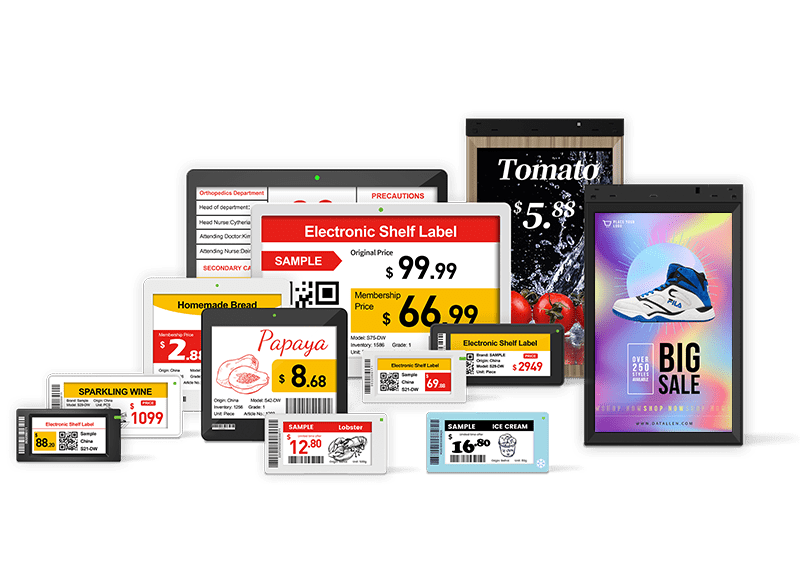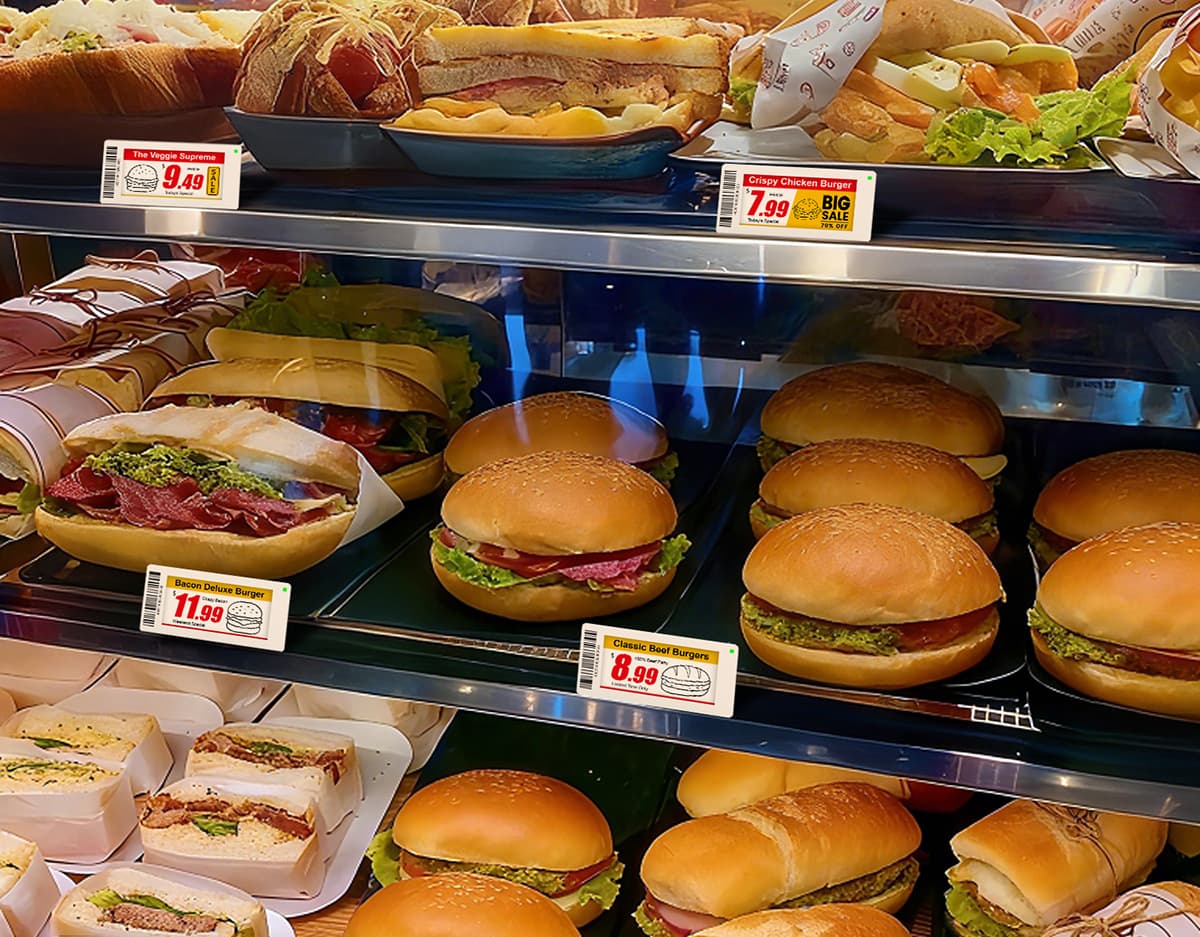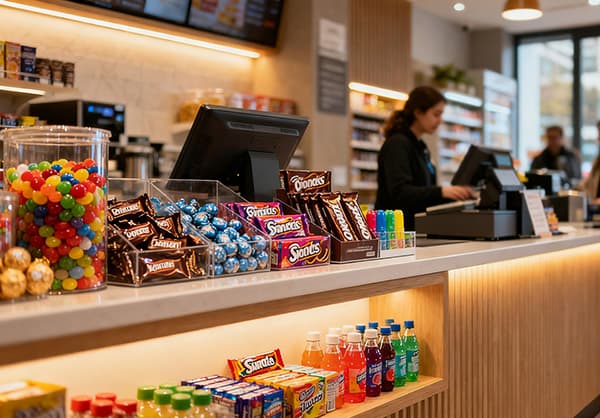Quick service restaurants (QSRs) have become the backbone of global foodservice, generating over $1.1 trillion in annual sales worldwide and projected to grow at a 6% CAGR through 2030. In the U.S., QSRs represent nearly 45% of the restaurant market, while in the Middle East, growth is fueled by a young population and rising urban demand.
Yet, this rapid expansion brings sharper competition, higher customer expectations, and pressure on operational efficiency. In this environment, creative retail displays—enhanced by digital technologies—are no longer optional but essential for capturing attention, driving sales, and building lasting brand differentiation.
Why Retail Displays Matter for Quick Service Restaurants
Why are retail displays so important in a quick-service restaurant? The answer lies in the fundamental nature of QSRs: high customer traffic and fast-paced environments that demand instantaneous communication. Visual displays significantly impact customer decision speed and brand memorability—studies show approximately 70% of restaurant impulse purchases originate from visible displays. Professional display design can increase average order value by 15% and table turnover speed by 20%, directly impacting profitability.
Global giants like McDonald's and Starbucks have mastered this art. In Middle Eastern markets, McDonald's incorporates local cultural elements into their display designs during Ramadan, while Starbucks in the US uses seasonal thematic displays to create emotional connections with customers, demonstrating how strategic displays enhance both brand relevance and customer experience.
Creative Retail Display Ideas That Drive Engagement
What are the most effective creative retail display ideas for QSRs? Based on successful implementations across global markets, several approaches deliver exceptional results:
1. Thematic Seasonal Displays: Holiday themes (Christmas, Ramadan, Halloween) create limited-time excitement and urgency. For instance, KFC's seasonal campaigns in Malaysia generated significant revenue increases through purpose-led displays.
2. Interactive Menu Zones: Digital menus and dynamic advertising screens enable real-time content updates. AOC's digital signage solutions for Chinese restaurant chains demonstrate how dynamic content can increase visual appeal and sales.
3. Grab-and-Go Sections: Strategically placed shelf/refrigerator displays facilitate quick meal pickup during peak hours, reducing congestion and improving customer flow.
4. Storytelling Through Design: Wall graphics and strategic lighting design create immersive environments. Greyhound Café in Bangkok uses industrial aesthetics with neon accents to create memorable visual experiences.
5. Localized Cultural Elements: Incorporating regional cultural motifs into displays enhances community connection. KFC's "Cara Kita" campaign in Malaysia featured 14 murals across 14 states, each painted by local artists to celebrate national diversity.
6. Strategic Sideboard Displays: These "silent salespeople" include:
-High-frequency consumption type: Creating "self-service add-on zones" for complementary items
-Quality trust type: Building "ingredient promotion boards" highlighting fresh components
-Scene guidance type: Creating "atmosphere catalysts" that enhance the dining experience
7. Low-Cost Implementation Strategies: Using modified water cartons, foam boxes, and other affordable materials can achieve a dramatic visual impact without significant investment.
How Smart Restaurant Technology Transforms Displays: From Digital Signage to Electronic Shelf Labels
How can smart restaurant technology improve retail display strategies? The integration of digital solutions is revolutionizing QSR displays.
Digital Signage: The Visual Core of Modern QSRs
Digital menu boards offer revolutionary advantages:
-Real-time menu item and price updates responding to market changes and inventory fluctuations
-High-quality graphics and videos enhancing visual appeal (increasing sales by up to 28%)
-Remote management of multi-store content, ensuring brand consistency across locations
Electronic Shelf Labels: The Operational Efficiency Revolution
ESL systems provide compelling advantages:
- Rapid price changes: Updating thousands of price tags in minutes instead of hours
- Near-zero error rate (0.00001%), eliminating price inconsistency issues
- Long-term cost reduction: 5+ years of usage per electronic price tag with minimal maintenance
-Sunlight readability: Suitable for drive-thru areas and outdoor displays
-Paper-like quality: Enhancing premium visual effects while maintaining digital functionality
Smart integration scenarios include:
-Dynamic pricing strategies: Automatic price adjustments based on time periods and demand patterns
-Inventory management integration: Real-time stock status display with expiration alerts
-Nutrition information transparency: Displaying allergen information and ingredient details
-POS system synchronization: Reducing errors and shortening checkout time
Implementation Considerations and Case Examples
Successful implementation requires addressing several technical considerations:
-Compatibility with existing POS and ERP systems ensures seamless data flow
-Hardware selection based on restaurant environment (size, connectivity, durability)
-Data analysis and display integration strategies maximize ROI
Datallen has developed specialized solutions for QSR environments, helping establishments balance initial investment with long-term benefits through scalable, integrated display systems.
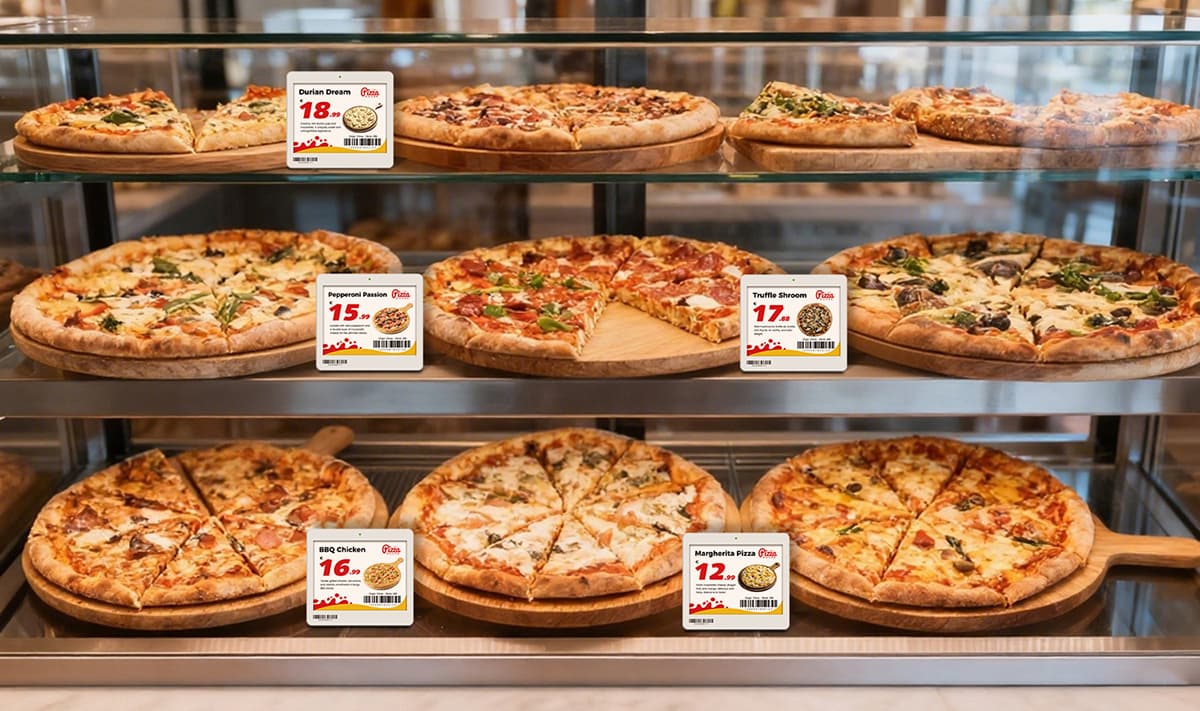
Smart Tables and Interactive Experiences: Redefining the Dining Environment
ESL technology serves as the core of smart table experiences:
-Replacing traditional table cards with digital displays showing exclusive service codes and featured recommendations
-Enabling direct scanning to access ordering or service call processes, improving service efficiency
- Providing flexibility for table number and guest information changes during banquet scenarios
Interactive experience design enhances engagement:
- Providing games and entertainment content through tabletop displays increases dining pleasure
- Integrating social media interaction encourages user-generated content and sharing
- Delivering personalized recommendations based on customer order history and preferences
Takeout and Drive-Thru Innovative Display Strategies
Optimizing Takeout Experience
- Professional takeout packaging serves as mobile billboards extending brand presence beyond the restaurant
- Takeout order pickup area design enhances brand experience extension
- Integrated digital signage displays order status and promotional information, reducing perceived wait times
Drive-Thru Innovations
-Digital menu boards with AI recommendation algorithms increase average order value by suggesting complementary items
-Personalized welcome messages and customized experiences based on license plate recognition create unique customer interactions
-Dual-lane designs improve efficiency compared to traditional single-lane drive-thru configurations
Balancing Functionality and Creativity in QSR Displays
How to balance aesthetics with operational efficiency in display design? This fundamental question requires understanding that in QSR environments, functionality must precede form. Successful displays must accommodate:
- Clear product categorization for intuitive customer navigation
- Intuitive price display facilitating quick decision-making
- Efficient traffic flow design, preventing congestion during peak hours
Technology enables this balance through automated pricing systems, dynamic inventory alerts, and intelligent promotion reminders that maintain aesthetic appeal while ensuring operational excellence.
Practical Tips for Implementing Creative Retail Display Ideas
What practical steps should QSRs take to implement creative retail displays? These actionable strategies ensure successful implementation:
1. Start with small-scale testing: Introduce e-ink displays in beverage areas or limited menu sections before full implementation
2. Analyze customer traffic data: Determine optimal screen/display placement based on actual customer movement patterns
3. Train staff comprehensively: Ensure team members understand how to use smart restaurant technology effectively
4 . Measure ROI systematically: Track sales increases, customer satisfaction metrics, and operational efficiency improvements
5. Monitor effects continuously: Track additional order rates, average order values, and dwell time changes to optimize displays
Case Highlights: Smart Displays in Quick Service Restaurants
United States: Digital signage implementations in drive-thru environments have demonstrated 15-25% improvements in order conversion rates through strategic product placement and promotional messaging.
Middle East: Electronic shelf labels have proven exceptionally stable in fast-food chains operating in high-temperature environments (up to 40°C), demonstrating reliability under extreme conditions.
Datallen Solutions: Integrated digital signage solutions help chain restaurants unify the management of promotional content across multiple locations while maintaining local relevance through customized messaging.
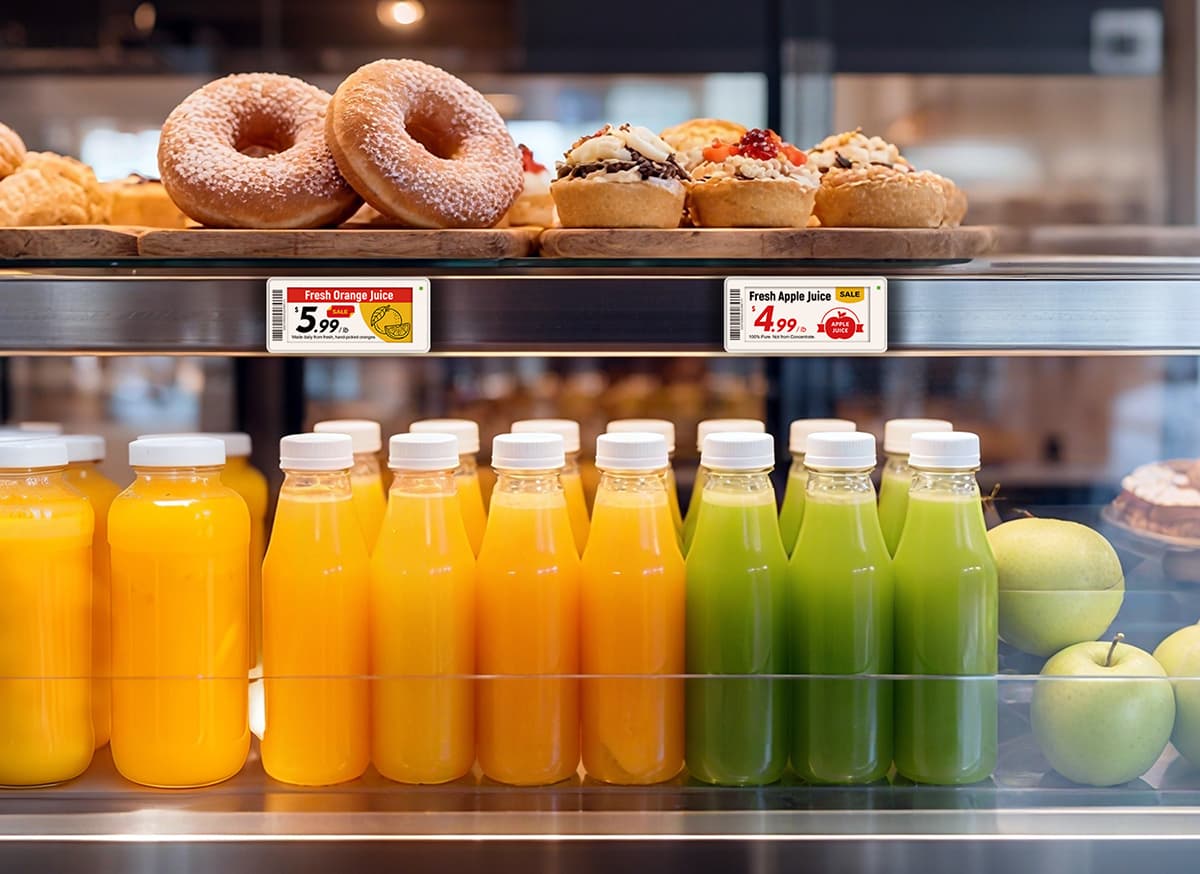
Future Trends in Creative Retail Displays for QSRs
What are the future trends in QSR retail display design? Several emerging technologies will shape tomorrow's displays:
-AI-driven digital menu recommendations will personalize suggestions based on customer preferences, time of day, and weather conditions
-Personalized advertising will leverage customer data to deliver tailored messages based on individual habits and time periods
-Sustainable materials and eco-friendly displays will gain prominence as environmental concerns influence consumer choices
-Deeper integration with smart restaurant technology will create seamless experiences from kitchen to dining room
Emerging technology integration includes:
-Artificial intelligence and predictive analysis: Enabling anticipatory service concepts that anticipate customer needs
-Augmented reality menu experiences: Visualizing food through phone cameras before ordering
-IoT device integration: Creating seamless connections between smart kitchens and front-end displays
Sustainable development directions focus on:
-Application of eco-friendly materials in retail displays
-Digital solutions reducing paper waste through electronic alternatives
-Energy efficiency optimization and carbon footprint reduction throughout the display lifecycle
Conclusion: Action Guide for Building the Future QSR
As the industry continues its digital transformation, technologies like electronic shelf labels and digital signage will play increasingly central roles in creating engaging, efficient dining experiences. Datallen continues exploring innovative solutions that balance technological sophistication with practical implementation, helping QSRs navigate the complex landscape of modern retail displays.
Explore Datallen's integrated solutions for digital signage and electronic shelf labels designed specifically for quick-service environments.
For more insights, check out:
1. Creative Deli |دلي Display Ideas for Modern Delicatessens
2. How to Create Effective Retail Store Advertising?
3. Pricing Intelligence for Retailers: Strategies, Tools, and Real-World Applications
4. POP Marketing Mastery: How Point of Purchase Materials in Retail Drives Sales
5. Retail’s Paperless Shift- Key Technologies Driving Green Retailing

